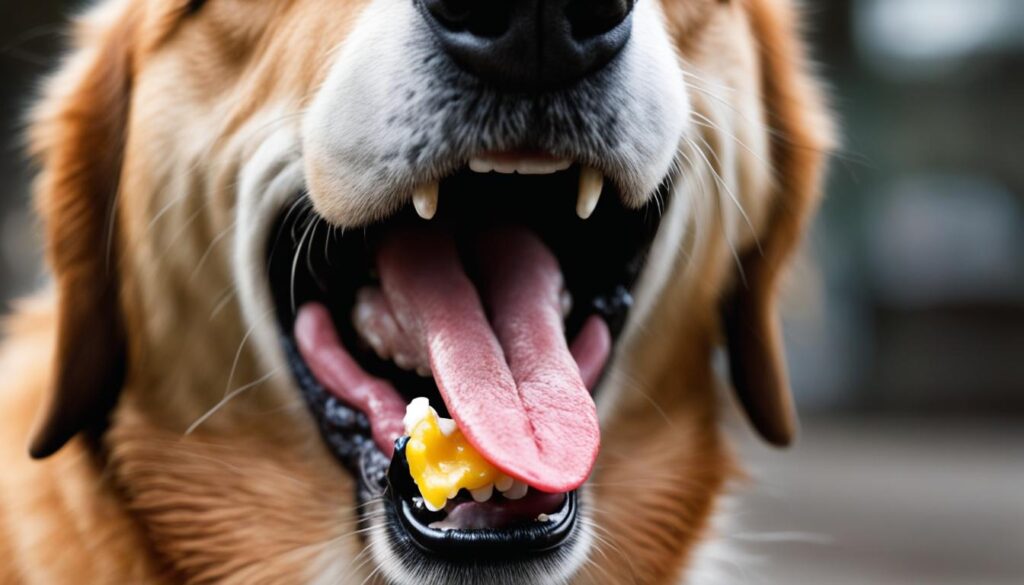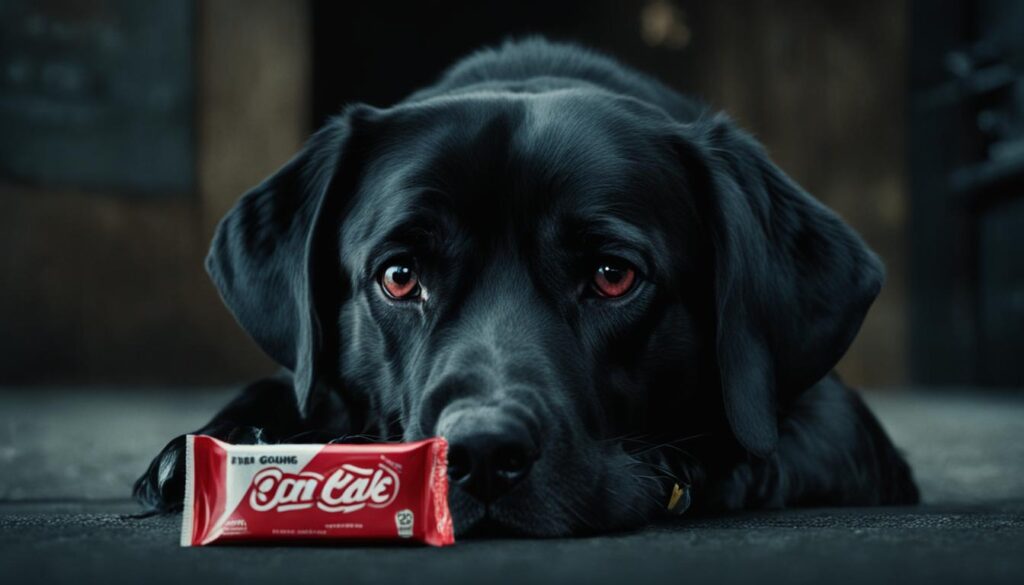As a responsible pet owner, it’s important to be aware of the potential dangers that certain foods and substances can pose to your furry friend. One such concern is whether dogs can eat gum. Gum may seem harmless, but it can actually be quite dangerous for dogs, particularly if it contains xylitol.
Xylitol is a low-calorie artificial sweetener that is commonly found in sugar-free gum. While it may be safe for humans, it can be toxic to dogs. Even small amounts of xylitol can cause poisoning in dogs, leading to a range of serious health consequences.
Key Takeaways:
- Gum can be dangerous for dogs, especially varieties that contain xylitol.
- Xylitol ingestion can lead to low blood sugar, seizures, liver damage, and other serious health issues in dogs.
- If your dog has ingested gum, especially one that contains xylitol, it is crucial to seek immediate veterinary care.
- Be cautious of other products that may contain xylitol, such as sugar-free candies, peanut butter, toothpaste, and certain medications.
- Preventing gum poisoning in dogs involves dog-proofing your home and providing dog-safe treats.
Xylitol Poisoning in Dogs: Symptoms and Effects

Xylitol poisoning in dogs can have harmful effects on their health. When dogs consume gum containing xylitol, it can lead to various symptoms and serious consequences. It is crucial to be aware of these symptoms and understand the effects of xylitol poisoning in dogs.
Symptoms of Xylitol Poisoning
Dogs that ingest gum with xylitol may exhibit the following symptoms:
- Stumbling
- Vomiting
- Pale gums
- Weakness
- Seizures
- Loss of consciousness
The rapid release of insulin in dogs due to xylitol ingestion leads to low blood sugar levels, which can cause weakness and stumbling. Severe liver damage is another significant effect of xylitol poisoning.
If your dog has swallowed gum containing xylitol, it is essential to monitor for these symptoms. If any of these signs appear, immediate veterinary attention is necessary to prevent further complications.
Xylitol Poisoning and Blood Sugar Levels
Xylitol ingestion causes a rapid decrease in blood sugar levels in dogs, leading to low blood sugar or hypoglycemia. This condition can be life-threatening if left untreated. Dogs experiencing low blood sugar may exhibit weakness, seizures, or loss of consciousness.
If you suspect xylitol poisoning, it is crucial to seek veterinary care immediately to stabilize your dog’s blood sugar levels and prevent further complications.
Severe Liver Damage
Xylitol poisoning can result in severe liver damage in dogs. The presence of xylitol triggers an excessive release of insulin, which can overwhelm the liver’s capacity to metabolize it. This leads to liver dysfunction and potential liver failure.
Severe liver damage can have serious consequences for a dog’s overall health and well-being. Prompt veterinary intervention is essential to address the liver damage and provide appropriate treatment.
| Effects of Xylitol Poisoning in Dogs | Symptoms |
|---|---|
| Low blood sugar levels | Stumbling, weakness, seizures |
| Severe liver damage | Liver dysfunction, potential failure |
Note: The table summarizes the effects of xylitol poisoning in dogs. It highlights the symptoms associated with low blood sugar levels and severe liver damage.
If you suspect your dog has ingested gum containing xylitol, it is essential to seek immediate veterinary care for diagnosis and treatment. Early intervention can significantly improve your dog’s prognosis and minimize the potential harm caused by xylitol poisoning.
Emergency Treatment for Xylitol Poisoning

If your dog has ingested gum with xylitol, it is considered an emergency, and immediate veterinary care is necessary. There is no antidote for xylitol poisoning, but the vet will closely monitor your dog’s blood sugar levels and liver function. Treatment may include administering an IV glucose solution to stabilize blood sugar levels. It is crucial to contact the nearest animal emergency hospital for urgent care in case of xylitol poisoning.
When a dog consumes gum containing xylitol, it can lead to severe health complications. The toxic effects of xylitol on a dog’s body can result in low blood sugar, seizures, liver damage, and even death. As a responsible pet owner, it is vital to understand the signs and symptoms of xylitol poisoning and seek immediate professional help.
Signs of Xylitol Poisoning
If you suspect that your dog has ingested gum with xylitol or any other product containing this toxic substance, look out for the following signs:
- Vomiting
- Weakness
- Stumbling or unsteady gait
- Seizures
- Pale gums
- Loss of consciousness
If your dog displays any of these symptoms, it is crucial to act quickly. Delaying treatment can worsen the condition and jeopardize your dog’s health. Contact your veterinarian immediately or the Pet Poison Helpline for guidance on what steps to take before bringing your dog to the clinic.
“Xylitol poisoning in dogs is a critical situation that requires immediate veterinary intervention. The effects of xylitol on a dog’s body can be life-threatening, and every minute counts. Seeking prompt professional help is crucial to ensure the best possible outcome for your furry friend.” – Dr. Lisa Wilson, DVM
Gum Poisoning Treatment
Once at the veterinary clinic, the veterinarian will assess your dog’s condition and take appropriate measures to address xylitol poisoning. Treatment may include:
- Inducing vomiting to remove any remaining xylitol from the stomach, if applicable and within the recommended time frame.
- Monitoring blood sugar levels, administering IV fluids, and providing supportive care to stabilize your dog’s condition.
- Administering an IV glucose solution to counteract the effects of low blood sugar caused by xylitol ingestion.
- Conducting blood tests to assess liver function and providing liver-protective medications, if necessary.
- Observing your dog closely for potential complications and managing them accordingly.
It is important to follow your veterinarian’s instructions carefully and provide any necessary follow-up care or medications to ensure your dog’s complete recovery. Xylitol poisoning can have long-term effects on a dog’s health, so ongoing monitoring may be required.
| Symptoms of Xylitol Poisoning | Treatment for Xylitol Poisoning |
|---|---|
| Vomiting | Inducing vomiting, IV fluids, frequent monitoring |
| Weakness | IV glucose solution, supportive care |
| Stumbling or unsteady gait | Monitoring blood sugar, liver function tests |
| Seizures | Liver-protective medications, observation |
| Pale gums | Closely monitoring for complications |
| Loss of consciousness |
It cannot be stressed enough that xylitol poisoning is a medical emergency. Time is of the essence when dealing with xylitol ingestion in dogs. Immediate action is crucial to give your dog the best chance of recovery.
Other Products Containing Xylitol

Xylitol is not only found in gum but also in various other products that your dog may come across. It is important to be vigilant and contact your vet immediately if your dog consumes anything containing xylitol. Here are some common products that may contain xylitol:
- Sugar-free candies
- Peanut butter
- Toothpaste
- Chewable vitamins
- Nasal sprays
- Sunscreen
- Deodorant
- Baby wipes
- Hair products
- Certain human medications
It is crucial to read product labels carefully and ensure that your dog does not have access to these items. Stick to dog-safe food options and treats to keep your furry friend safe and healthy.
Gum Without Xylitol: Intestinal Blockage Risks

While not all sugar-free gum contains xylitol, dogs eating gum can still pose a risk of intestinal blockage. Large pieces of gum can obstruct the digestive tract, leading to symptoms such as vomiting, lack of energy, abdominal pain, constipation, or loss of appetite. If your dog exhibits these signs, it is important to seek veterinary attention promptly.
Gum chewing is a common habit for many people, but it can be hazardous to our furry friends. Dogs are curious creatures and may mistake gum for a tasty treat. While gum without xylitol is not considered toxic to dogs, there are still risks involved when they consume it.
The dangers of dogs eating gum go beyond the potential toxicity of xylitol. Even gum that doesn’t contain this artificial sweetener can cause problems for dogs. The main concern is the risk of intestinal blockage.
When dogs ingest large pieces of gum, these sticky substances can adhere to the gastrointestinal tract and cause an obstruction. This can lead to serious symptoms such as vomiting, lack of energy, abdominal pain, constipation, or loss of appetite.
If you notice any of these signs, it is crucial to take your dog to the veterinarian as soon as possible. An intestinal blockage can be a life-threatening condition that requires immediate medical attention.
Preventing gum-related intestinal blockage:
- Avoid leaving gum accessible to dogs. Keep it out of reach in closed containers or high places.
- If you have children in the house, educate them about the dangers of dogs consuming gum and the importance of keeping it away from pets.
- Be cautious during walks or visits to parks, as gum can be found on the ground. Keep a close eye on your dog to prevent them from ingesting it.
Remember, even though gum without xylitol may not be toxic to dogs, it can still pose a serious risk to their health. By being vigilant and taking preventive measures, you can help keep your canine companion safe from the dangers of gum ingestion.
Xylitol Poisoning Prognosis and Treatment
When it comes to xylitol poisoning in dogs, the prognosis is generally good if prompt treatment is obtained. Immediate veterinary care is crucial to monitor blood sugar levels and liver function, as well as provide necessary treatments to mitigate the effects of xylitol poisoning. Mild increases in liver enzyme levels, which are common with xylitol ingestion, usually resolve within a few days.
Early intervention plays a significant role in ensuring a positive outcome for dogs affected by gum toxicity. Vets may administer IV glucose solutions to stabilize blood sugar levels and closely monitor liver function throughout the treatment process. By closely observing the dog’s response to treatment, veterinarians can assess the dog’s progress and adjust the treatment plan accordingly.
It is important for pet owners to understand the potential risks associated with chewing gum and to seek immediate veterinary care in the event of xylitol poisoning. Timely treatment can significantly increase the chances of recovery and minimize the potential long-term effects of gum toxicity in dogs.
Preventing Gum Poisoning in Dogs

Preventing gum poisoning in dogs is essential to ensure their safety and well-being. By taking a few simple precautions, you can protect your furry friend from the dangers of dogs eating gum.
Dog-Proof Your Home
The first step in preventing gum poisoning is to dog-proof your home. Keep gum and other xylitol-containing products out of your dog’s reach by storing them in secure, high cabinets or containers. Be mindful of where you keep your gum, whether it’s in your purse, trash cans, or even in your car. Make sure these areas are inaccessible to your dog to prevent any accidental ingestion.
Be Mindful of Other Products
It’s not just gum that can be a risk for dogs – other products may also contain xylitol. Take extra care when it comes to sugar-free candy, peanut butter, and other items that may contain this artificial sweetener. Always check the ingredients before sharing any food with your canine companion to ensure it doesn’t contain xylitol or any other harmful ingredients.
Stick to Dog-Friendly Snacks
Instead of sharing human snacks, opt for dog-friendly treats that are safe for your furry friend. There are many delicious and healthy options available that are specifically designed for dogs. These treats not only satisfy their cravings but also promote good health and dental hygiene.
By being proactive and implementing these preventative measures, you can significantly reduce the risk of gum poisoning in your beloved canine companion.
Snippets of what they might look like (The snippet is part of the page that appears in the search engine results):
“Preventing gum poisoning in dogs is essential to ensure their safety and well-being. By taking a few simple precautions, you can protect your furry friend…”
| Preventive Measures | Benefits |
|---|---|
| Dog-Proof Your Home | Ensures gum and xylitol-containing products are out of reach |
| Be Mindful of Other Products | Avoids accidental ingestion of xylitol in sugar-free candy and peanut butter |
| Stick to Dog-Friendly Snacks | Promotes good health and dental hygiene |
Implementing these preventive measures will safeguard your dog’s well-being and keep them away from the dangers associated with dogs eating gum. Take the necessary steps to protect your furry friend and enjoy their company without worrying about potential hazards.
Xylitol Toxicity in Dogs: Increased Awareness

The number of xylitol pet poisonings has seen a significant increase in recent years, shedding light on the critical need for heightened awareness regarding the dangers that xylitol ingestion poses to dogs. Xylitol is a common ingredient found in various products, including gum, candy, peanut butter, and dental products. As responsible pet owners, it is essential to familiarize ourselves with the symptoms and effects of xylitol poisoning to safeguard the health and well-being of our furry companions.
Unlike humans, dogs are particularly vulnerable to the adverse effects of xylitol. When consumed, xylitol stimulates a rapid release of insulin in dogs, causing a dangerous drop in blood sugar levels, known as hypoglycemia. Severe cases of xylitol poisoning can also lead to liver damage and failure, further exacerbating the health risks associated with its ingestion.
“Xylitol poisoning in dogs can have devastating consequences, and it’s crucial for pet owners to be aware of the potential dangers. A moment of carelessness could spell disaster for our beloved pets.”
– Dr. Emily Thompson, Veterinary Specialist
By educating ourselves about the dangers of xylitol toxicity, we can take proactive steps to mitigate the risks. Identifying and avoiding products containing xylitol is the first and most crucial step. Always read labels carefully and opt for dog-friendly alternatives. Additionally, keep all potentially hazardous items securely stored out of your pet’s reach to prevent accidental ingestion.
Recognizing the Symptoms of Xylitol Poisoning
To protect our dogs from the harmful effects of xylitol, it’s essential to be vigilant and able to recognize the signs of xylitol poisoning. The symptoms may vary depending on the amount of xylitol ingested and can include:
- Weakness and lethargy
- Vomiting and diarrhea
- Loss of coordination
- Seizures
- Jaundice (yellowing of the skin and eyes)
- Difficulty breathing
Should you notice any of these symptoms or suspect xylitol poisoning, immediate veterinary care is crucial. Time is of the essence in treating xylitol toxicity, and prompt intervention can make a significant difference in your dog’s prognosis.
Increasing awareness about xylitol poisoning and understanding its potentially life-threatening consequences is paramount in safeguarding the health and well-being of our canine companions. By staying informed and taking necessary precautions, we can protect our dogs from the dangers of xylitol ingestion and provide them with a safe and healthy environment.
Immediate Actions for Xylitol Poisoning
If you suspect that your dog has consumed gum or any other product containing xylitol, it is crucial to take immediate action. Contact your veterinarian or the Pet Poison Helpline for guidance. Do not induce vomiting or give anything orally to your dog without professional advice. Prompt veterinary care is essential to minimize the effects of xylitol poisoning.
| Immediate Actions for Xylitol Poisoning in Dogs | |
|---|---|
| Step 1 | Contact your veterinarian or the Pet Poison Helpline for guidance. |
| Step 2 | Do not induce vomiting or give anything orally to your dog without professional advice. |
| Step 3 | Transport your dog to a veterinary clinic or animal emergency hospital immediately. |
| Step 4 | Follow any additional instructions provided by your veterinarian. |
Remember, time is of the essence when it comes to xylitol poisoning. Delayed treatment can lead to severe complications and even be life-threatening for your beloved canine companion. By acting swiftly and seeking veterinary care, you can greatly improve the chances of a positive outcome.
Quote:
“Immediate action is crucial when it comes to xylitol poisoning in dogs. Contact your veterinarian right away for guidance and transportation to a veterinary clinic or animal emergency hospital.” – Dr. Emily Johnson
Xylitol in Common Household Products
Xylitol, a substance toxic to dogs, is not only found in gum but is also present in various household products. It’s essential for pet owners to be aware of these potential sources of xylitol and take necessary precautions to protect their dogs from accidental ingestion. Some common household products containing xylitol include:
- Chewable vitamins
- Nasal sprays
- Sunscreen
- Deodorant
- Makeup and hair products
- Some human medications
- Baby wipes
If your dog ingests any of these products, it is important to contact your veterinarian immediately for guidance and assistance. Swift action can help prevent severe health complications resulting from xylitol toxicity.
| Household Product | Potential Xylitol Content |
|---|---|
| Chewable vitamins | May contain xylitol as a sweetener |
| Nasal sprays | Some nasal sprays contain xylitol as a moisturizing agent |
| Sunscreen | Some sunscreens contain xylitol for its cooling effect |
| Deodorant | Xylitol can be present in deodorants for its antibacterial properties |
| Makeup and hair products | Xylitol can be found in certain cosmetic and hair care items |
| Some human medications | Certain medications may contain xylitol as an inactive ingredient |
| Baby wipes | Some baby wipes contain xylitol for its antimicrobial properties |
Non-Xylitol Gum Risks and Symptoms
While gum without xylitol is generally safe for dogs to consume, there are still risks associated with swallowing large pieces of gum. The main concern is the potential for intestinal blockage, which can cause discomfort and digestive complications for your furry friend.
Symptoms of an intestinal blockage in dogs include:
- Vomiting
- Lack of energy
- Abdominal pain
- Constipation
- Loss of appetite
If you notice any of these symptoms in your dog after they have swallowed gum, it is important to seek veterinary attention as soon as possible. An intestinal blockage can be a serious condition that requires prompt medical intervention.
It is worth noting that the likelihood of an intestinal blockage increases if your dog has consumed a large amount of gum or if they have a habit of swallowing gum regularly. In these cases, it is crucial to take preventive measures and closely monitor your dog for any signs of digestive distress.
Remember, while non-xylitol gum may not be toxic to dogs, it is still important to prevent them from swallowing large pieces to avoid potential complications. If you have concerns about your dog’s gum-chewing habits, consult with your veterinarian for guidance on safe chewing alternatives.
Wrapping Up
Understanding the dangers of dogs eating gum, especially varieties containing xylitol, is crucial for pet owners. Xylitol poisoning can lead to severe consequences and requires immediate veterinary care. It is important to dog-proof your home and ensure that gum and other xylitol-containing products are kept out of reach. Providing dog-safe treats can also help protect your dog’s health.
If you suspect your dog has ingested gum with xylitol, it is essential to contact your veterinarian right away for guidance and treatment. Prompt intervention is key to minimizing the effects of xylitol poisoning. Remember, preventive measures are vital in ensuring the well-being of your furry friend.
By staying informed and taking proactive steps, you can help keep your dog safe from the dangers of gum ingestion. Remember, if you suspect xylitol poisoning or have any concerns about your dog’s health, always consult with a veterinary professional for expert advice and care.
FAQ
Can dogs eat gum?
No, dogs should not eat gum as it can be dangerous for their health.
What are the dangers of dogs eating gum?
The main danger is that certain varieties of gum contain xylitol, a toxic substance for dogs. Xylitol ingestion can lead to low blood sugar, seizures, liver damage, and other serious health consequences.
What are the symptoms and effects of xylitol poisoning in dogs?
Xylitol poisoning can result in symptoms such as stumbling, vomiting, pale gums, weakness, seizures, and loss of consciousness. It causes a rapid release of insulin in dogs, leading to low blood sugar levels. Severe liver damage can also occur.
What should I do if my dog has consumed gum with xylitol?
If your dog has ingested gum with xylitol, it is considered an emergency, and immediate veterinary care is necessary. Contact the nearest animal emergency hospital and do not induce vomiting or give anything orally to your dog without professional advice.
What other products may contain xylitol?
Xylitol is not only found in gum but also in various other products, including sugar-free candies, peanut butter, toothpaste, chewable vitamins, nasal sprays, sunscreen, deodorant, baby wipes, hair products, and certain human medications.
What are the risks of swallowing gum without xylitol?
While gum without xylitol is not considered toxic to dogs, there is still a risk of intestinal blockage if a dog swallows large pieces of gum. Symptoms of an intestinal blockage may include vomiting, lack of energy, abdominal pain, constipation, or loss of appetite.
What is the prognosis for xylitol poisoning in dogs?
The prognosis is good if prompt treatment is obtained. Veterinary care is essential to monitor blood sugar levels and liver function and provide necessary treatments. Mild increases in liver enzyme levels usually resolve within a few days with early intervention.
How can I prevent gum poisoning in dogs?
To prevent gum poisoning in dogs, dog-proof your home and ensure that gum and other xylitol-containing products are kept out of reach. Be cautious of gum found in purses, trash cans, cars, or on the ground. Stick to dog-safe treats and avoid sharing food that may contain xylitol or other harmful ingredients.
Why is increased awareness about xylitol toxicity important?
The number of xylitol pet poisonings has increased in recent years, highlighting the importance of increased awareness about the dangers of xylitol ingestion in dogs. Pet owners should familiarize themselves with the symptoms and effects of xylitol poisoning to protect their dogs’ health.
What should I do if I suspect xylitol poisoning in my dog?
If you suspect xylitol poisoning, contact your veterinarian or the Pet Poison Helpline for guidance. Do not induce vomiting or give anything orally to your dog without professional advice. Prompt veterinary care is essential to minimize the effects of xylitol poisoning.
Where else can xylitol be found apart from gum?
Xylitol is not only found in gum but also in various household products like chewable vitamins, nasal sprays, sunscreen, deodorant, makeup and hair products, some human medications, and even baby wipes.
What are the risks and symptoms of non-xylitol gum?
While gum without xylitol is not considered toxic to dogs, there is still a risk of intestinal blockage if large pieces of gum are swallowed. Symptoms of an intestinal blockage may include vomiting, lack of energy, abdominal pain, constipation, or loss of appetite.






